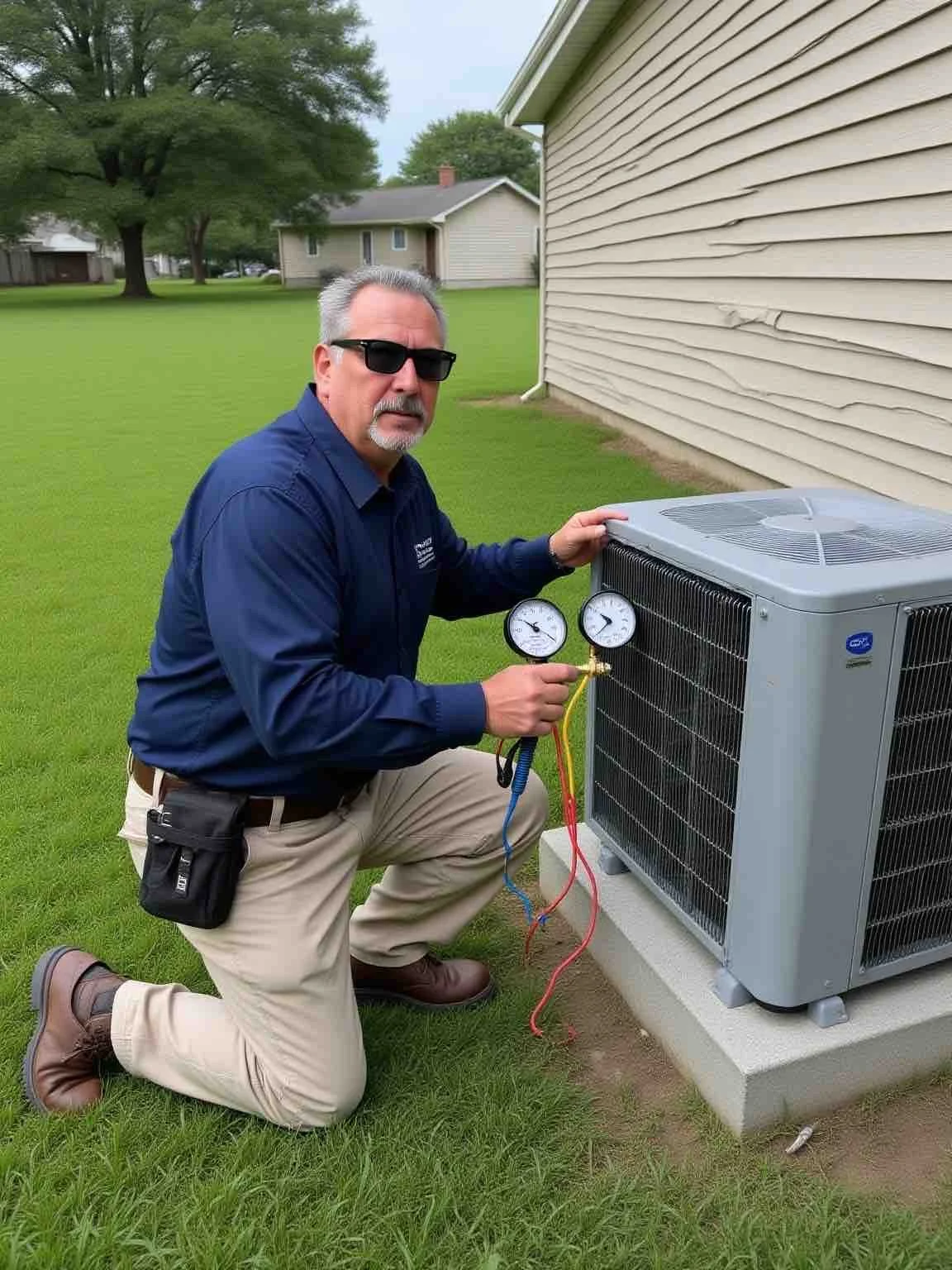In recent years, significant shifts in refrigerant regulations have been set into motion — and they’re beginning to impact homeowners in a real way. If you have an older air-conditioning or heat‐pump unit, this matters. Below is a full breakdown of what’s changing, why it’s changing, and what you as a homeowner should be thinking about, particularly if your system is getting older or uses what will become “obsolete” refrigerants.
1. What’s Changing? The Basics
Under the American Innovation and Manufacturing (AIM) Act, the U.S. Environmental Protection Agency (EPA) is phasing down the use of high-Global-Warming-Potential (GWP) refrigerants such as many HFCs (hydrofluorocarbons).
For residential A/C and heat-pump systems, one of the key dates is January 1, 2025: from that date, new equipment must meet a lower GWP limit (in U.S., the limit is around 750 GWP) meaning that refrigerants like R‑410A (GWP ~2,000) can no longer be used in newly manufactured systems.
The replacement refrigerants are typically what the industry calls “A2L” class (mildly flammable) low-GWP options such as R‑454B and R‑32.
How It Affects “Old” Systems
If your AC/heat-pump unit was already installed before the regulation cutoff and uses R-410A (or even older refrigerants), it does not immediately become illegal or unusable. Systems can continue operating under existing refrigerants.
But — the availability, cost, and servicing of older refrigerants and parts may become more challenging over time (and more expensive).
2. Why the Change?
Environmental Drivers
Many older refrigerants had very high GWP meaning when they leak or are released, they contribute disproportionately toward global warming. R-410A has a GWP of over 2,000.
The move to lower-GWP refrigerants aligns with the U.S. commitments under the AIM Act and global agreements like the Kigali Amendment to the Montreal Protocol.
Efficiency & Modernization
New refrigerants often allow for more efficient systems, or at least systems that are designed with modern safety and performance standards.
Also, by mandating new refrigerants in new systems, the industry encourages newer, more efficient equipment — gradually phasing out very old technology.
3. How This Impacts Homeowners With Older / Obsolete Units
Here are some of the key implications you should be aware of if your home has an older HVAC unit:
a) Servicing & Refrigerant Availability
For older systems using R-410A: You can still have it serviced for now — repairs and recharges are still possible.
BUT: Over time, R-410A production/import will decline — meaning costs may go up, lead times may increase, especially if someone leaks frequently.
If your system uses a much older refrigerant (e.g., R‑22, which was largely phased out years ago), servicing is already more difficult and expensive.
b) Compatibility & Retrofit Limitations
New refrigerant types (A2L) are not compatible with older system components designed for R-410A or R-22 without major modifications. So you can’t just swap refrigerants in many cases.
Older units will remain legal, but when they fail, it may make more sense to replace rather than repair — because parts, refrigerant, labor may cost more than replacement.
c) Replacement Timing & Cost Considerations
If your system is aging (10-15 years or more), this refrigerant transition is a good prompt to evaluate replacement. Waiting until after the new equipment becomes standard may mean higher cost of equipment or installation.
On the flip side, if your unit is fairly new and working well, you might continue with it confidently — but maintain it well to extend its life.
d) Home Value, Efficiency, & Future Proofing
A newer system using low-GWP refrigerant may enhance home efficiency, reduce utility costs, and possibly add value.
If you sell your home in a few years, buyers may ask about the HVAC age, what refrigerant is used, and servicing implications.
Even though older units aren’t immediately “obsolete,” you may face increased risk of failure or higher repair cost, so budgeting ahead is smart.
4. What You Should Do Now: A Checklist for Homeowners
Here’s a practical guide to help you navigate the change.
✅ Inspect & Document Your Current System
Determine the age of your HVAC system (outdoor unit label often shows installation date).
Find out what refrigerant your unit uses (look for sticker or ask your HVAC technician).
Has it had frequent repairs or refrigerant leaks? If yes, that signals possible replacement sooner.
✅ Assess Repair vs. Replace
Ask yourself:
Is the unit 12+ years old and still using an older refrigerant?
Have repair/maintenance costs been rising?
Is efficiency dropping (bills increasing, comfort decreasing)?
If yes → upgrading may make sense.
If your system is newer (say < 8–10 years), well-maintained and efficient → you may continue to use it for now.
✅ Talk to a Qualified HVAC Professional
Ensure the technician is certified under Section 608 of the Clean Air Act (required to handle refrigerants).
Ask about:
Availability of parts for your system
Future servicing outlook for your refrigerant
Cost estimates for replacement vs. repair
If replacement, what refrigerant the new system uses and how that might affect price and installation
✅ Consider Budgeting and Timing
If you expect replacement is likely soon, you might want to lock in installation before demand and price increases for new‐refrigerant systems take effect.
Look into rebates, tax credits, or financing options (some states or utilities may offer incentives for high-efficiency or low-GWP systems).
Don’t wait until a breakdown — unexpected failure means you may have to pick whatever is available (and possibly more expensive) in a rush.
✅ Maintain Your Existing Unit Well
If you decide to keep your current system for now:
Regular service (filter changes, leak checks, coils clean) helps prolong life.
Monitor energy bills and comfort levels for signs of decline.
Keep an eye on refrigerant leaks — since older refrigerant cost may go up.
Save for a replacement fund — that way you’re prepared when the time comes.
5. Common Questions & Misconceptions
❓ “Does this mean I
must replace my unit by 2025?”
No — existing units can continue using their current refrigerant and operate legally. The new rules apply to new manufacture of equipment (and sale/installation deadlines) rather than forcing immediate replacement of every old unit.
❓ “If my unit uses R-410A, am I safe?”
Yes, in the sense that it’s still serviceable for now. But you should be aware of the longer-term servicing risks (availability of refrigerant/parts) and plan accordingly.
❓ “Can I just retrofit my current system to a new refrigerant?”
Generally no — many older systems are not compatible with low-GWP A2L refrigerants without major redesign, and it’s often not cost-effective. Replacement is usually more sensible.
❓ “Are the new refrigerants safe?”
Yes — but they have different characteristics (for instance, A2L refrigerants are mildly flammable, so installations must follow updated code & safety standards). Proper installation by trained professionals is key.
❓ “Will a new system cost more because of refrigerant changes?”
Possibly — new equipment incorporating new refrigerant technology may have higher upfront cost (due to redesign, training of installers, safety requirements).
6. Final Thoughts
If you’re a homeowner with an older HVAC system, especially one that uses R-410A (or older), this refrigerant transition should serve as a wake-up call — not a panic. Your system doesn’t instantly become obsolete, but the window for “smooth and cost-effective” servicing is gradually closing.
By taking a little time now to inspect your system, talk to a qualified HVAC professional, and plan for the future — you’ll put yourself in a strong position. Whether you choose to keep your current system for the near term or upgrade soon, you’ll be making a more informed decision.


